Impact of Short Circuit Ratio on Harmonic Distortion in Offshore Wind Farm Integration
Abstract
1. Introduction
- This study investigates the relationship between SCR and THD in offshore wind farms at 154 kV and 345 kV through detailed simulations. In the 345 kV system, THD shows non-monotonic variations due to shifting resonance bands. Approximate SCR ranges that minimize resonance effects are identified: above ~14 for 154 kV and above ~71 for 345 kV, providing practical guidance for wind farm design.
- Harmonic levels from the IEC 61400-21-2 summation method are compared with simulation results under various SCR conditions. Significant deviations, particularly around the 11th to 13th harmonics, indicate that simulations are necessary in low- to medium-SCR systems for accurate harmonic assessment.
- Seasonal load variations are used to estimate SCR distributions for 66 candidate offshore wind farm sites, enabling evaluation of voltage THD across actual sites and highlighting the importance of SCR and harmonic interactions in integration planning.
2. Proposed Methodology
2.1. Simulation Model Configuration
2.2. Concept of the Summation Method
3. Simulations
3.1. Standard Framework for Harmonic Assessment
3.2. Comparison Based on the Summation Method
3.3. Harmonic Assessment Based on SCR
4. Case Study
4.1. SCR-Based Harmonic Assessment Considering Parallel Resonance Harmonic Orders
4.2. SCR-Based Harmonic Assessment at Offshore Wind Farm Candidate Sites
5. Discussion
6. Conclusions
Author Contributions
Funding
Institutional Review Board Statement
Informed Consent Statement
Data Availability Statement
Conflicts of Interest
References
- Kaldellis, J.K.; Kapsali, M. Shifting towards offshore wind energy—Recent activity and future development. Energy Policy 2013, 53, 136–148. [Google Scholar] [CrossRef]
- Esteban, M.D.; Diez, J.J.; López, J.S.; Negro, V. Why offshore wind energy? Renew. Energy 2011, 36, 444–450. [Google Scholar] [CrossRef]
- Bilgili, M.; Yasar, A.; Simsek, E. Offshore wind power development in Europe and its comparison with onshore counterpart. Renew. Sustain. Energy Rev. 2011, 15, 905–915. [Google Scholar] [CrossRef]
- Ullah, T.; Sobczak, K.; Liśkiewicz, G.; Khan, A. Two-Dimensional URANS Numerical Investigation of Critical Parameters on a Pitch Oscillating VAWT Airfoil under Dynamic Stall. Energies 2022, 15, 5625. [Google Scholar] [CrossRef]
- Williams, R.; Zhao, F. Global Offshore Wind Report 2024; Global Wind Energy Council: Brussels, Belgium, 2024. [Google Scholar]
- Samanta, S.; Yang, B.; Seo, G.-S. Stability analysis of power systems with high penetration of state-of-the-art inverter technologies. Energies 2025, 18, 3645. [Google Scholar] [CrossRef]
- Santamaria, K.S.; Rios, M.A. Challenges of power systems with IBR-dominated in specific regions: Analysis of transient stability and SCR. In Proceedings of the 2025 IEEE Workshop on Power Electronics and Power Quality Applications (PEPQA), Cartagena, Colombia, 4 June 2025. [Google Scholar]
- Rodrigues, S.; Restrepo, C.; Kontos, E.; Teixeira Pinto, R.; Bauer, P. Trends of offshore wind projects. Renew. Sustain. Energy Rev. 2015, 49, 1114–1135. [Google Scholar] [CrossRef]
- Higgins, P.; Foley, A. The evolution of offshore wind power in the United Kingdom. Renew. Sustain. Energy Rev. 2014, 37, 599–612. [Google Scholar] [CrossRef]
- Woo, H.; Choi, S.; Kim, S.; Kim, S.; Kwak, J. Hybrid AC/DC transmission expansion planning considering offshore windfarms in Korea. In Proceedings of the 2024 IEEE Power & Energy Society General Meeting (PESGM), Seattle, WA, USA, 21–25 July 2024. [Google Scholar]
- Muyeen, S.M.; Takahashi, R.; Tamura, J. Operation and control of HVDC-connected offshore wind farm. IEEE Trans. Sustain. Energy 2010, 1, 30–37. [Google Scholar] [CrossRef]
- Bresesti, P.; Kling, W.L.; Hendriks, R.L.; Vailati, R. HVDC connection of offshore wind farms to the transmission system. IEEE Trans. Energy Convers. 2007, 22, 37–43. [Google Scholar] [CrossRef]
- Wang, L.; Yeh, C.-J.; Hsieh, M.-H.; Wu, C.-T.; Lu, C.-L. Analysis of voltage variations and short-circuit ratios of a large-scale offshore wind farm connected to a practical power system. In Proceedings of the 2013 IEEE Power & Energy Society General Meeting, Vancouver, BC, Canada, 21–25 July 2013. [Google Scholar]
- Schmall, J.; Huang, S.-H.F.; Li, Y.; Billo, J.; Conto, J.; Zhang, Y. Voltage stability of large-scale wind plants integrated in weak networks: An ERCOT case study. In Proceedings of the 2015 IEEE Power & Energy Society General Meeting, Denver, CO, USA, 26–30 July 2015. [Google Scholar]
- Monjo, L.; Sainz, L.; Liang, J.; Pedra, J. Study of resonance in wind parks. Electr. Power Syst. Res. 2015, 128, 30–38. [Google Scholar] [CrossRef]
- He, X.; Chen, C. The harmonic stability analysis of HVDC system based on short-circuit ratio. In Proceedings of the 2012 Asia-Pacific Power and Energy Engineering Conference, Shanghai, China, 27–29 March 2012. [Google Scholar]
- Zhou, Y.; Nguyen, D.D.; Kjær, P.C.; Saylors, S. Connecting wind power plant with weak grid—Challenges and solutions. In Proceedings of the 2013 IEEE Power & Energy Society General Meeting, Vancouver, BC, Canada, 21–25 July 2013. [Google Scholar]
- Zhang, Y.; Huang, S.-H.F.; Schmall, J.; Conto, J.; Billo, J.; Rehman, E. Evaluating system strength for large-scale wind plant integration. In Proceedings of the 2014 IEEE PES General Meeting|Conference & Exposition, National Harbor, MD, USA, 27–31 July 2014. [Google Scholar]
- Zhou, J.; Zhao, F.; Wu, H.; Wang, X. Comparison analysis of short circuit ratio variants on the indication of power system voltage stability. In Proceedings of the 2024 IEEE 15th International Symposium on Power Electronics for Distributed Generation Systems (PEDG), Luxembourg, 23–26 June 2024. [Google Scholar]
- IEC 61400-21; Wind Turbines—Part 21: Measurement and Assessment of Power Quality Characteristics of Grid Connected Wind Turbines. International Electrotechnical Commission: Geneva, Switzerland, 2008.
- IEC 61000-4-7; Electromagnetic Compatibility (EMC)—Part 4–7: Testing and Measurement Techniques—General Guide on Harmonics and Interharmonics Measurements and Instrumentation, for Power Supply Systems and Equipment Connected Thereto. International Electrotechnical Commission: Geneva, Switzerland, 2002.
- IEC 61000-4-15; Electromagnetic Compatibility (EMC)—Part 4–15: Testing and Measurement Techniques—Flickermeter—Functional and Design Specifications. International Electrotechnical Commission: Geneva, Switzerland, 2010.
- IEC 61000-4-30; Electromagnetic Compatibility (EMC)—Part 4–30: Testing and Measurement Techniques—Power Quality Measurement Methods. International Electrotechnical Commission: Geneva, Switzerland, 2015.
- IEC 61000-3-6; Electromagnetic Compatibility (EMC)—Part 3–6: Limits—Assessment of Emission Limits for Fluctuating Loads in MV and HV Power Systems. International Electrotechnical Commission: Geneva, Switzerland, 2008.
- IEC 61000-3-7; Electromagnetic Compatibility (EMC)—Part 3–7: Assessment of the Emission Limits for the Connection of Fluctuating Installations to MV, HV and EHV Power Systems. International Electrotechnical Commission: Geneva, Switzerland, 2008.
- IEEE Std 519; IEEE Recommended Practices and Requirements for Harmonic Control in Electric Power Systems. IEEE: New York, NY, USA, 2014.
- IEEE Std 2800; IEEE Recommended Practices for Wind and Solar Power Plant Integration with Electric Power Systems: Harmonic Current Limits and System Impact Assessment. IEEE: New York, NY, USA, 2022.
- IEEE Std 1547; IEEE Standard for Interconnection and Interoperability of Distributed Energy Resources with Associated Electric Power Systems Interfaces. IEEE: New York, NY, USA, 2018.
- Alfalahi, S.T.Y.; Saeed, M.N.; Alsammarraie, R.M.; Abdulhadi, M.; Nouh, A.; Alkahtani, A.A.; Al-Shetwi, A.Q. Harmonic Distortion Analysis and Mitigation in an On-Grid Wind Farm Using Passive Filters: A Case Study on the Shahat Distribution Network. J. Inf. Syst. Eng. Manag. 2025, 10 (Suppl. S44), 8661. [Google Scholar] [CrossRef]
- Li, G.Y.; Yen, H.J.; Wu, J.W.; Huang, W.Y.; Chang, G.W. A Comparative Study of Harmonic Distortion Assessment for an Offshore Wind Farm System. In Proceedings of the 2024 21st International Conference on Harmonics and Quality of Power (ICHQP), Chengdu, China, 18 October 2024; pp. 451–456. [Google Scholar]
- Lu, S.-Y.; Wang, L.; Ke, S.-C.; Chang, C.-H.; Yang, Z.-H. Evaluation of measured power-quality results of a wind farm connected to Taiwan power system. In Proceedings of the 2014 IEEE Industry Application Society Annual Meeting, Vancouver, BC, Canada, 5–9 October 2014. [Google Scholar]
- Magesh, T.; Devi, G.; Lakshmanan, T. Measurement and simulation of power quality issues in grid connected wind farms. Electr. Power Syst. Res. 2022, 210, 108142. [Google Scholar] [CrossRef]
- Kocatepe, C.; İnan, A.; Arıkan, O.; Yumurtacı, R.; Kekezoğlu, B.; Baysal, M.; Bozkurt, A.; Akkaya, Y. Power quality assessment of grid-connected wind farms considering regulations in Turkey. Renew. Sustain. Energy Rev. 2009, 13, 2553–2561. [Google Scholar] [CrossRef]
- Xia, Q.; Wang, Z.; Liu, F.; Li, Y.; Peng, Y.; Xu, Z. Study on power quality issues of wind farm. In Proceedings of the 2017 36th Chinese Control Conference (CCC), Dalian, China, 26–28 July 2017. [Google Scholar]
- Liang, X. Emerging power quality challenges due to integration of renewable energy sources. IEEE Trans. Ind. Appl. 2017, 53, 855–866. [Google Scholar] [CrossRef]
- Shao, H.; Henriques, R.; Morais, H.; Tedeschi, E. Power quality monitoring in electric grid integrating offshore wind energy: A review. Renew. Sustain. Energy Rev. 2024, 191, 114094. [Google Scholar] [CrossRef]
- Hoseinzadeh, B.; Bak, C.L.; Blaabjerg, F. Impact of grid impedance variations on harmonic emission of grid-connected inverters. In Proceedings of the 2017 IEEE Manchester PowerTech, Manchester, UK, 18–22 June 2017; pp. 1–5. [Google Scholar]
- Nakhodchi, N.; Bollen, M.H.J. Estimation of safe harmonic hosting capacity. In Proceedings of the CIRED 2021—The 26th International Conference and Exhibition on Electricity Distribution, Online, 21–24 June 2021; pp. 693–697. [Google Scholar]
- ABB. Technical Guide No. 6: Guide to Harmonics with AC Drives; ABB: Zürich, Switzerland, 2022. [Google Scholar]
- Cobben, J.F.G.; Geldtmeijer, D.A.M.; Almering, A.F.J.; van Waes, J.B.M. Evaluation and updating of harmonic voltage limits. In Proceedings of the 2015 IEEE Eindhoven PowerTech, Eindhoven, The Netherlands, 29 June–2 July 2015; pp. 1–5. [Google Scholar]
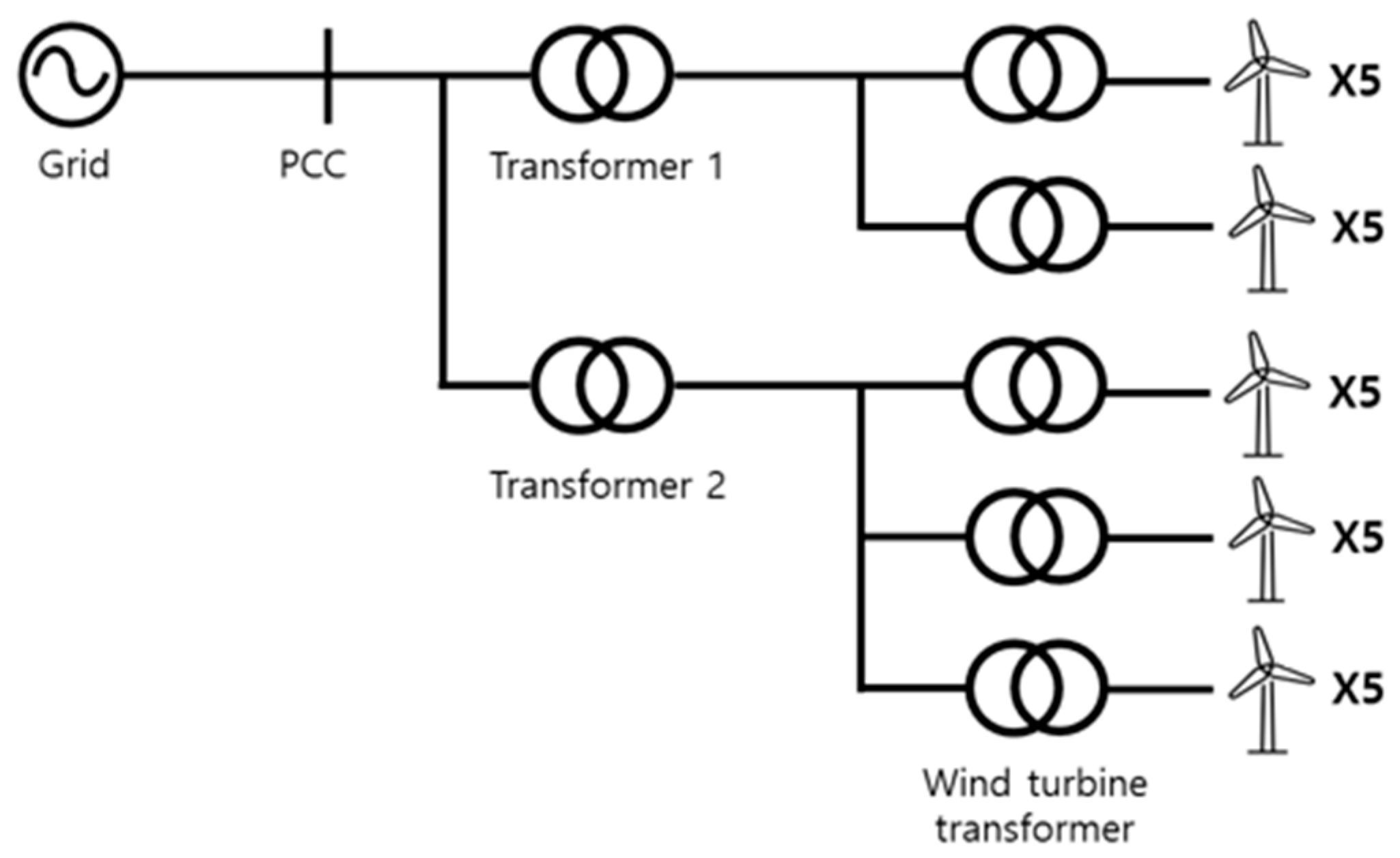
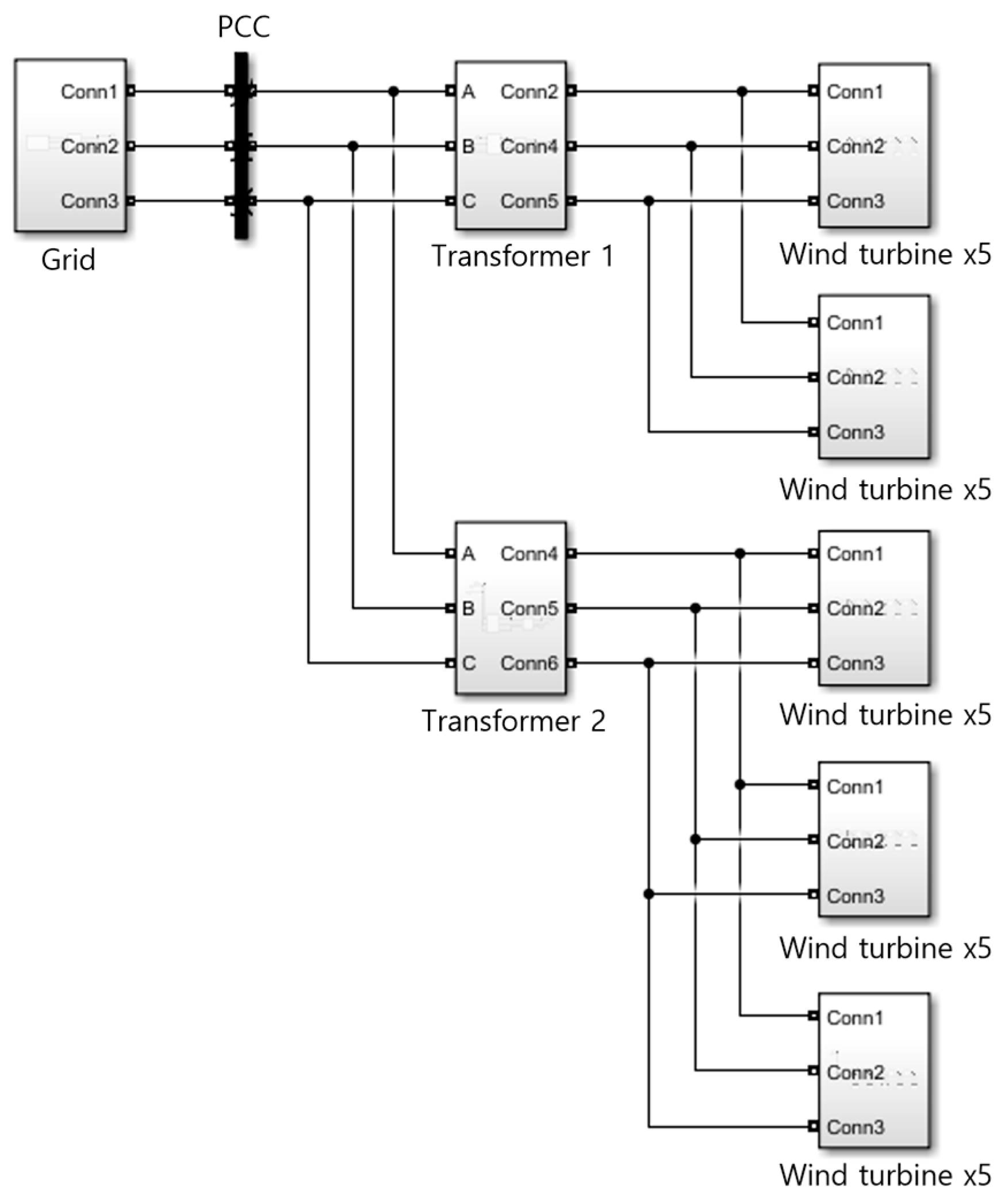
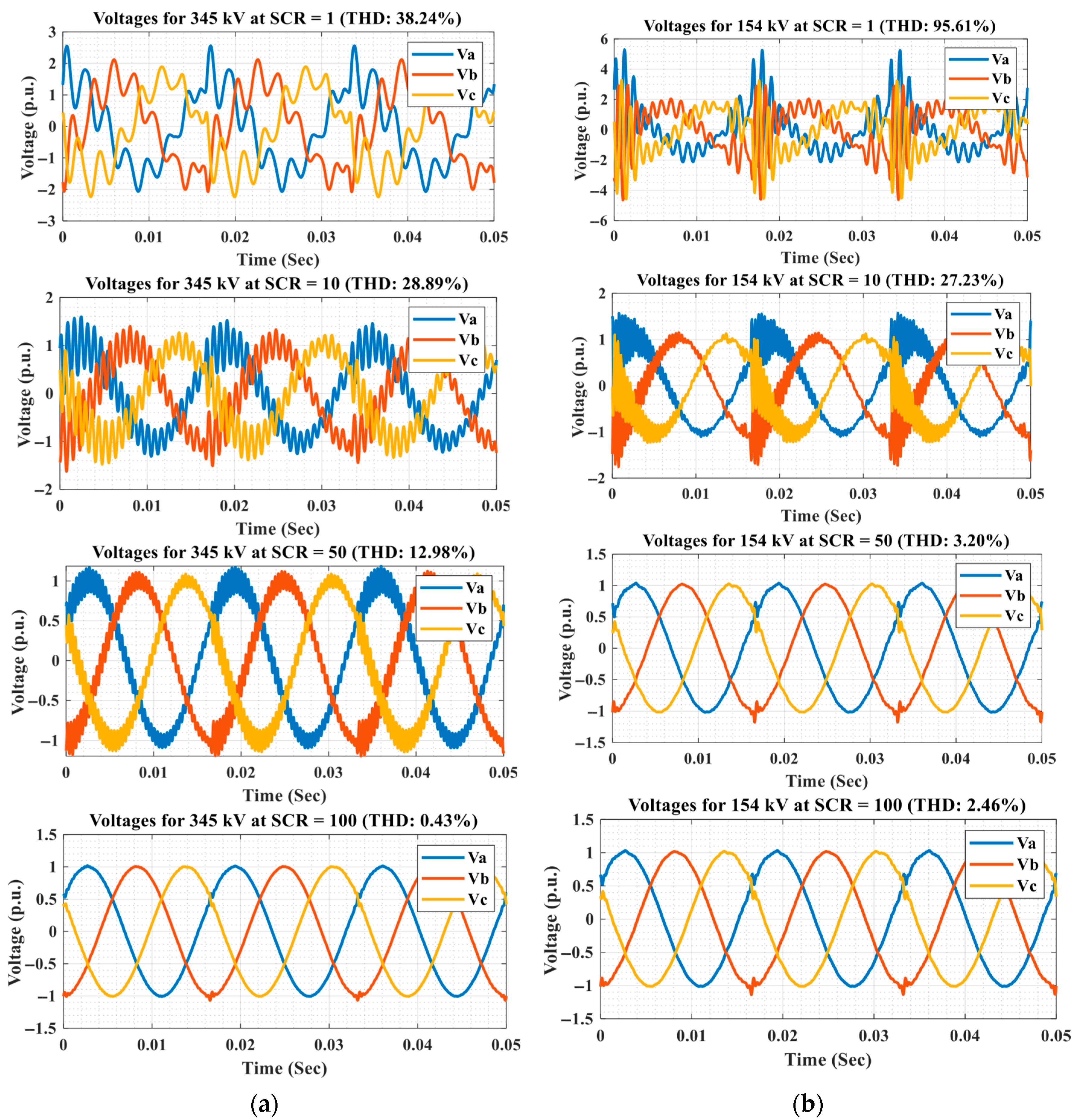
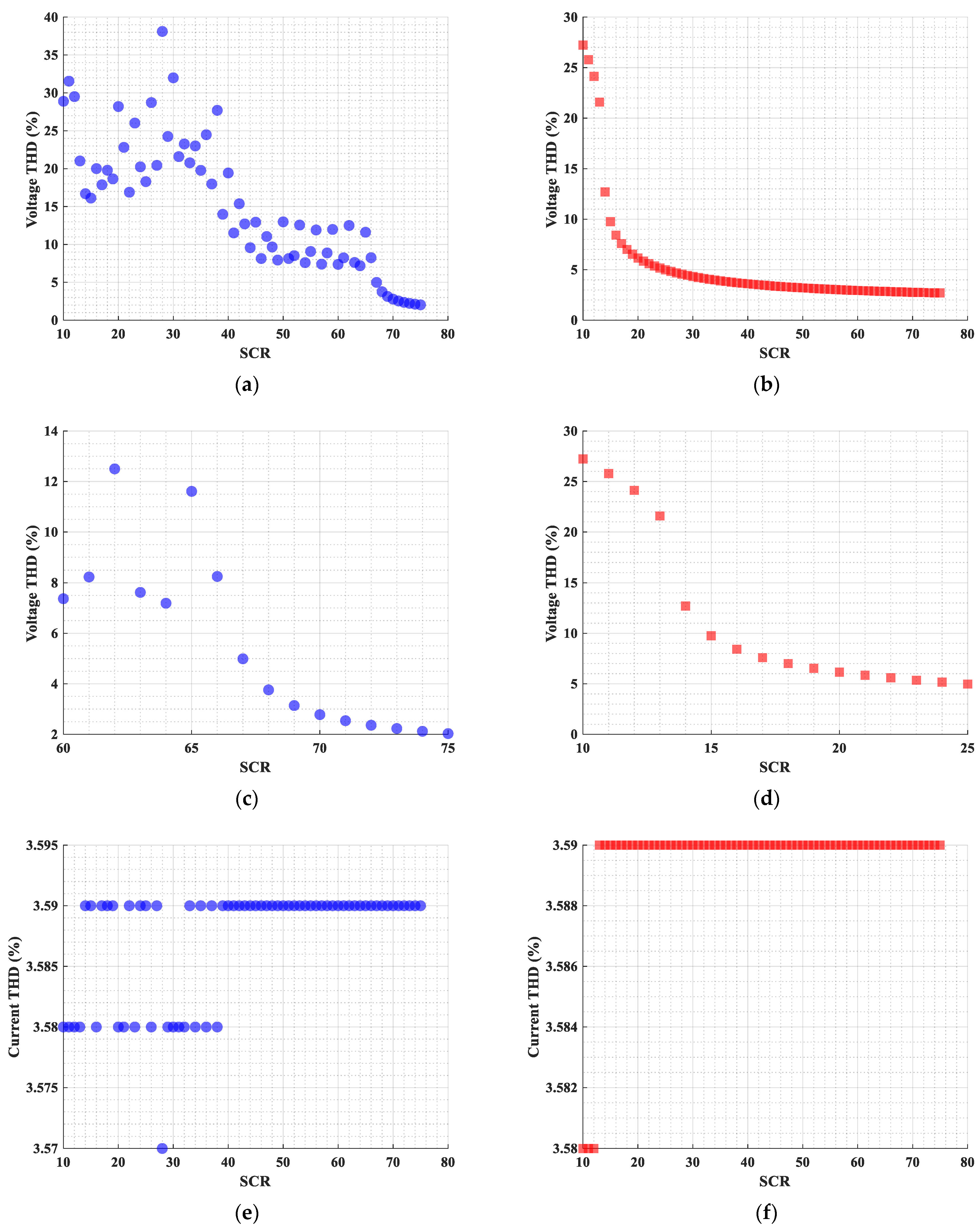
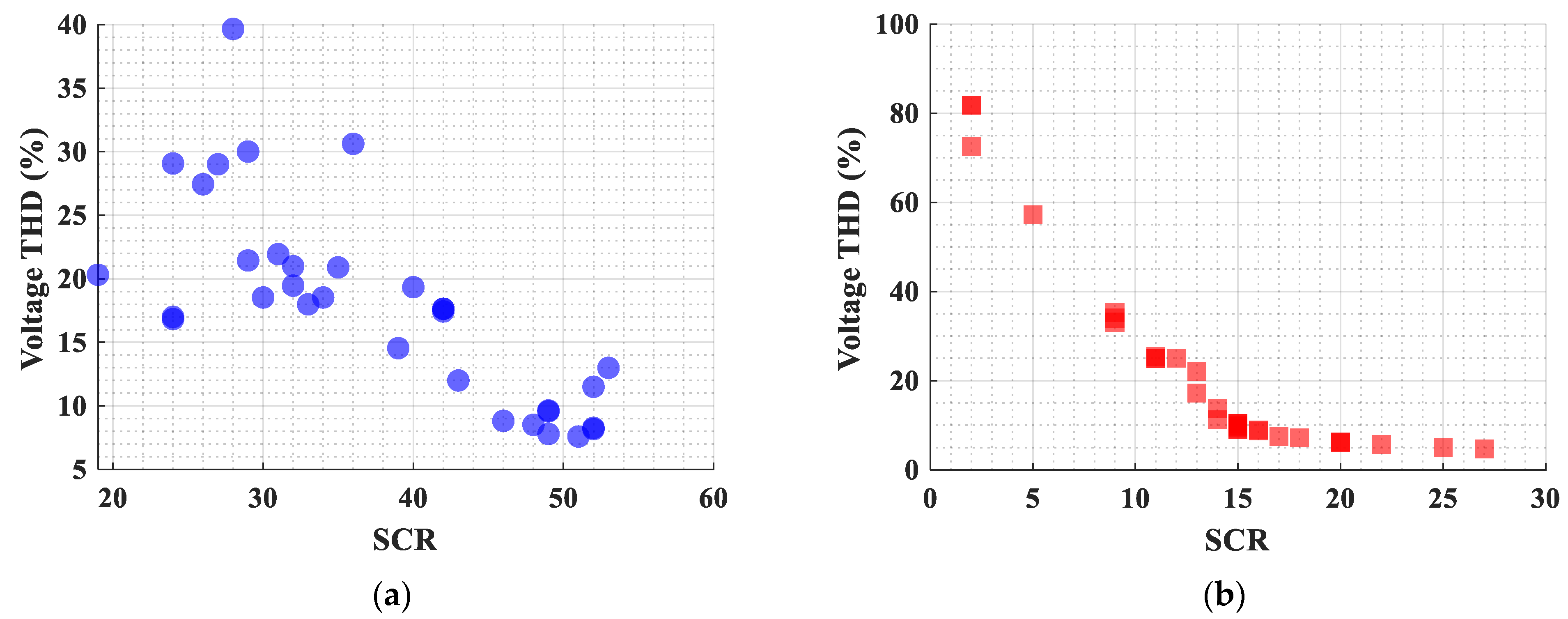
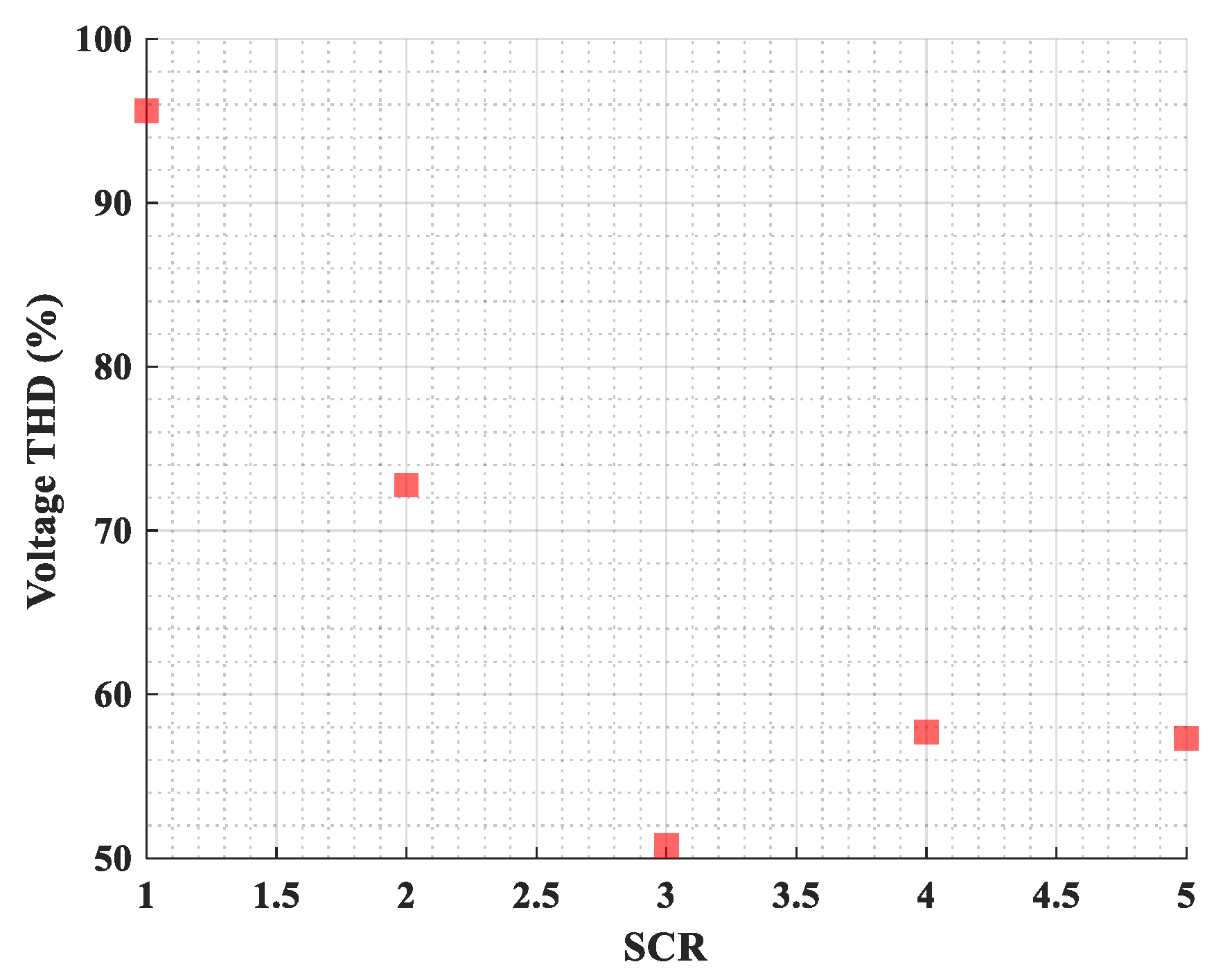
| Configuration | Phase Angle of Phase a (Degrees) | Frequency (Hz) | X/R Ratio |
|---|---|---|---|
| 0 | 60 | 7 |
| MV Line | ||
|---|---|---|
| Resistive (Ohms/km) | 0.2745 | |
| Reactive (H/km) | 0.001186 | |
| HV/EHV Line | ||
| Resistive (Ohms/km) | ||
| 0.0454 | 0.0113 | |
| Reactive (H/km) | ||
| 3.57 × 10−4 | 1.17 × 10−3 | |
| Capacitive (F/km) | ||
| 2.26 × 10−8 | 1.44 × 10−8 | |
| Transformer 1 | |
|---|---|
| Rated power | 300 MVA |
| Voltage | 345 kV/66 kV |
| 154 kV/66 kV | |
| Connection | Yg/D1 |
| Transformer 2 | |
| Rated power | 400 MVA |
| Voltage | 345 kV/66 kV |
| 154 kV/66 kV | |
| Connection | Yg/D1 |
| Wind Turbine Generator Transformer | |
| Rated power | 30 MVA |
| Voltage | 66 kV/8270 V |
| Connection | D11/Yg |
| Harmonic Order | Magnitude (% of Fundamental Current) | Harmonic Order | Magnitude (% of Fundamental Current) |
|---|---|---|---|
| 2 | 0.343 | 27 | 0.200 |
| 3 | 0.343 | 28 | 0.133 |
| 4 | 0.201 | 29 | 0.271 |
| 5 | 0.435 | 30 | 0.271 |
| 6 | 0.435 | 31 | 0.240 |
| 7 | 0.471 | 32 | 0.240 |
| 8 | 0.401 | 33 | 0.240 |
| 9 | 0.401 | 34 | 0.240 |
| 10 | 0.545 | 35 | 0.350 |
| 11 | 1.456 | 36 | 0.350 |
| 12 | 1.456 | 37 | 0.259 |
| 13 | 1.854 | 38 | 0.259 |
| 14 | 0.475 | 39 | 0.259 |
| 15 | 0.475 | 40 | 0.259 |
| 16 | 0.371 | 41 | 0.157 |
| 17 | 0.761 | 42 | 0.157 |
| 18 | 0.761 | 43 | 0.108 |
| 19 | 0.420 | 44 | 0.108 |
| 20 | 0.324 | 45 | 0.108 |
| 21 | 0.324 | 46 | 0.108 |
| 22 | 0.330 | 47 | 0.108 |
| 23 | 0.369 | 48 | 0.108 |
| 24 | 0.369 | 49 | 0.108 |
| 25 | 0.235 | 50 | 0.106 |
| 26 | 0.200 | - | - |
| Harmonic Order | Summed Harmonic Current (A) | Magnitude (% of Rated Current) | Harmonic Order | Summed Harmonic Current (A) | Magnitude (% of Rated Current) |
|---|---|---|---|---|---|
| 2 | 239.457 | 0.34 | 27 | 139.625 | 0.20 |
| 3 | 239.457 | 0.34 | 28 | 92.851 | 0.13 |
| 4 | 140.323 | 0.20 | 29 | 189.192 | 0.27 |
| 5 | 303.685 | 0.44 | 30 | 189.192 | 0.27 |
| 6 | 303.685 | 0.44 | 31 | 167.550 | 0.24 |
| 7 | 328.817 | 0.47 | 32 | 167.550 | 0.24 |
| 8 | 279.949 | 0.40 | 33 | 167.550 | 0.24 |
| 9 | 279.949 | 0.40 | 34 | 167.550 | 0.24 |
| 10 | 380.479 | 0.55 | 35 | 244.344 | 0.35 |
| 11 | 1016.472 | 1.46 | 36 | 244.344 | 0.35 |
| 12 | 1016.472 | 1.46 | 37 | 180.815 | 0.26 |
| 13 | 1294.33 | 1.85 | 38 | 180.815 | 0.26 |
| 14 | 331.610 | 0.48 | 39 | 180.815 | 0.26 |
| 15 | 331.610 | 0.48 | 40 | 180.815 | 0.26 |
| 16 | 259.005 | 0.37 | 41 | 109.606 | 0.16 |
| 17 | 531.274 | 0.76 | 42 | 109.606 | 0.16 |
| 18 | 531.274 | 0.76 | 43 | 75.398 | 0.11 |
| 19 | 293.213 | 0.42 | 44 | 75.398 | 0.11 |
| 20 | 226.193 | 0.32 | 45 | 75.398 | 0.11 |
| 21 | 226.193 | 0.32 | 46 | 75.398 | 0.11 |
| 22 | 230.382 | 0.33 | 47 | 75.398 | 0.11 |
| 23 | 257.609 | 0.37 | 48 | 75.398 | 0.11 |
| 24 | 257.609 | 0.37 | 49 | 75.398 | 0.11 |
| 25 | 164.060 | 0.24 | 50 | 75.398 | 0.11 |
| 26 | 139.625 | 0.20 | - | - | - |
| System | SCR | Harmonic Order | Summation (% of Rated Current) | Simulation (% of Rated Current) |
|---|---|---|---|---|
| 154 kV | 1 | 11th | 1.46 | 1.42 |
| 12th | 1.46 | 1.40 | ||
| 13th | 1.85 | 1.74 | ||
| 10 | 11th | 1.46 | 1.45 | |
| 12th | 1.46 | 1.45 | ||
| 13th | 1.85 | 1.85 | ||
| 50 | 11th | 1.46 | 1.45 | |
| 12th | 1.46 | 1.45 | ||
| 13th | 1.85 | 1.85 | ||
| 100 | 11th | 1.46 | 1.45 | |
| 12th | 1.46 | 1.45 | ||
| 13th | 1.85 | 1.85 | ||
| 345 kV | 1 | 11th | 1.46 | 1.46 |
| 12th | 1.46 | 1.46 | ||
| 13th | 1.85 | 1.85 | ||
| 10 | 11th | 1.46 | 1.45 | |
| 12th | 1.46 | 1.45 | ||
| 13th | 1.85 | 1.84 | ||
| 50 | 11th | 1.46 | 1.45 | |
| 12th | 1.46 | 1.45 | ||
| 13th | 1.85 | 1.85 | ||
| 100 | 11th | 1.46 | 1.45 | |
| 12th | 1.46 | 1.45 | ||
| 13th | 1.85 | 1.85 |
| Voltage THD (%) | ||||
|---|---|---|---|---|
| SCR | 1 | 10 | 50 | 100 |
| 345 kV | 38.24 | 28.89 | 12.98 | 0.43 |
| 154 kV | 95.61 | 27.23 | 3.20 | 2.46 |
| 154 kV | 345 kV | ||
|---|---|---|---|
| SCR | SCR | ||
| 4 | 29.81 | 4 | 13.89 |
| 10 | 43.90 | 10 | 21.60 |
| 20 | 56.19 | 20 | 29.76 |
| 30 | 63.32 | 30 | 35.56 |
| 50 | 71.52 | 50 | 43.84 |
Disclaimer/Publisher’s Note: The statements, opinions and data contained in all publications are solely those of the individual author(s) and contributor(s) and not of MDPI and/or the editor(s). MDPI and/or the editor(s) disclaim responsibility for any injury to people or property resulting from any ideas, methods, instructions or products referred to in the content. |
© 2025 by the authors. Licensee MDPI, Basel, Switzerland. This article is an open access article distributed under the terms and conditions of the Creative Commons Attribution (CC BY) license (https://creativecommons.org/licenses/by/4.0/).
Share and Cite
Lee, K.; Yoon, M.; Lee, J.; Gham, S.; Choi, S. Impact of Short Circuit Ratio on Harmonic Distortion in Offshore Wind Farm Integration. Energies 2025, 18, 5480. https://doi.org/10.3390/en18205480
Lee K, Yoon M, Lee J, Gham S, Choi S. Impact of Short Circuit Ratio on Harmonic Distortion in Offshore Wind Farm Integration. Energies. 2025; 18(20):5480. https://doi.org/10.3390/en18205480
Chicago/Turabian StyleLee, Kiryeon, Myungseok Yoon, Jonghyun Lee, Seungjun Gham, and Sungyun Choi. 2025. "Impact of Short Circuit Ratio on Harmonic Distortion in Offshore Wind Farm Integration" Energies 18, no. 20: 5480. https://doi.org/10.3390/en18205480
APA StyleLee, K., Yoon, M., Lee, J., Gham, S., & Choi, S. (2025). Impact of Short Circuit Ratio on Harmonic Distortion in Offshore Wind Farm Integration. Energies, 18(20), 5480. https://doi.org/10.3390/en18205480





